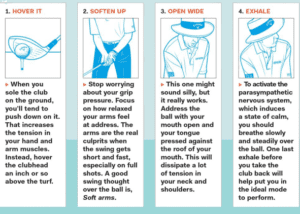Even for the most skilled golfers, slumps are a common occurrence. They can be exasperating, and demoralizing, and have a significant impact on your course performance. However, it is essential to remember that golf slumps are temporary and can be surmounted with the proper mentality.
Why golf slumps happen and the importance of getting out of them
Golf slumps often occur due to a combination of physical and mental factors. It could be a minor change in your swing mechanics, or it could be a lack of focus or confidence. Regardless of the cause, it’s crucial to address these issues promptly as they can affect your enjoyment of the game and your overall performance.
Now, let’s explore 10 practical tips to help you get out of a golf slump:
- Analyze Your Swing: Use video analysis to identify any changes in your swing mechanics.
- Practice Mindfully: Focus on quality over quantity during practice sessions.
- Take a Break: Sometimes, taking a break from golf can help reset your mind and body.
- Seek Professional Help: Consider getting a lesson from a professional golf instructor.
- Set Realistic Goals: Setting achievable goals can help boost your confidence.
- Maintain Physical Fitness: Regular exercise and stretching can improve your swing and reduce the risk of injuries.
- Stay Positive: Maintain a positive attitude, even when things aren’t going well.
- Visualize Success: Use visualization techniques to imagine successful shots.
- Play for Fun: Remember to enjoy the game and don’t put too much pressure on yourself.
- Persistence: Keep practicing and don’t give up.
Remember, every golfer experiences slumps at some point. The key is to stay patient, persistent, and positive as you work through it.

Signs and Symptoms of a Golf Slump
Recognizing the signs and symptoms of being in a golf slump
For avid golfers, experiencing a slump in their game can be frustrating and disheartening. It’s important to recognize the signs and symptoms of being in a golf slump so that you can take the necessary steps to overcome it.
- Inconsistent Performance: One of the most common signs of a golf slump is inconsistent performance on the course. You may find that your shots are not as accurate as they used to be, or that you are struggling with your swing. This inconsistency can lead to frustration and a decline in confidence.
- Mental Struggles: Golf is a mental game, and when you’re in a slump, you may find that your mental game is suffering. You may experience negative thoughts, self-doubt, and difficulty focusing on the task at hand. These mental struggles can further impact your performance on the course.
- Lack of Motivation: Another symptom of being in a golf slump is a lack of motivation to practice or play. You may find yourself losing interest in the game or feeling unmotivated to put in the necessary effort to improve. This lack of motivation can make it even more challenging to break out of the slump.
- Physical Tension: When you’re in a golf slump, you may also notice an increase in physical tension during your swings. This tension can lead to poor technique and further contribute to inconsistent performance.
Recognizing these signs and symptoms is the first step towards overcoming a golf slump. By addressing the underlying issues and seeking guidance from a golf instructor or mental coach, you can work towards getting your game back on track. Remember, slumps are temporary, and with the right mindset and approach, you can regain your confidence and enjoyment of the game.
Tip 1: Analyze Your Game
As a golfer, it’s crucial to understand that slumps are part of the game. They can be frustrating, but they also provide an opportunity for growth and improvement. The first step in overcoming a slump is to analyze your game.
Identifying weaknesses and areas for improvement in your golf game
Review Your Performance: Reflect on your recent rounds. Identify patterns, such as missed shots or poor decision-making, that may be contributing to your slump.
Assess Your Skills: Evaluate your strengths and weaknesses. This can help you focus on areas that need improvement.
Seek Professional Help: Consider working with a golf coach or instructor. They can provide objective feedback and suggest techniques to improve your game.
Use Technology: Golf technology, like swing analyzers or golf GPS devices, can provide valuable data about your game. This data can help identify areas for improvement.
Practice Mindfully: Quality of practice is more important than quantity. Make each practice session count by focusing on specific skills and using deliberate practice techniques.
Maintain Physical Fitness: Physical fitness plays a crucial role in golf performance. Regular exercise, particularly exercises that improve flexibility and strength, can enhance your game and prevent injuries.
Stay Positive: A positive mindset is key in overcoming a slump. Remember, every golfer experiences slumps; it’s how you respond that matters.
Here’s a summary table of the tips:
| Tip | Explanation |
|---|---|
| Review Your Performance | Reflect on recent rounds to identify patterns contributing to the slump |
| Assess Your Skills | Evaluate strengths and weaknesses to focus on areas needing improvement |
| Seek Professional Help | Work with a coach or instructor for objective feedback |
| Use Technology | Utilize golf tech for valuable data about your game |
| Practice Mindfully | Focus on specific skills during deliberate practice sessions |
| Maintain Physical Fitness | Regular exercise improves golf performance and prevents injuries |
| Stay Positive | Maintain a positive mindset during the slump |
Remember, slumps are temporary and provide an opportunity for growth. With patience, persistence, and the right approach, you’ll soon be back on track.
Tip 2: Practice with Purpose

As a dedicated golfer, you understand that golf is a game of skill, precision, and mental fortitude. However, there are times when even the most seasoned players find themselves in a slump. The key to overcoming this slump is to practice with purpose.
Effective practice techniques to regain confidence and consistency
1. Set Clear Goals: Establish what you want to achieve in each practice session. This could be improving your swing, putting, or chipping.
2. Quality over Quantity: Instead of mindlessly hitting balls for hours, focus on making each shot count. Pay attention to your stance, grip, and swing technique.
3. Use Training Aids: Utilize training aids like alignment sticks or swing trainers to help correct technical flaws.
4. Simulate Game Conditions: Practice under conditions that mimic actual game situations. This will prepare you for the pressures of the course.
5. Seek Professional Help: If you’re struggling to identify the cause of your slump, consider getting a lesson from a professional coach.
Here’s a table summarizing these tips:
| Tip | Explanation |
|---|---|
| Set Clear Goals | Define what you want to achieve in each practice session |
| Quality over Quantity | Focus on making each shot count rather than hitting balls for hours |
| Use Training Aids | Use tools like alignment sticks or swing trainers to correct technical flaws |
| Simulate Game Conditions | Practice under conditions similar to actual game situations |
| Seek Professional Help | Consider getting a lesson from a professional coach if you’re struggling |
Remember, every golfer experiences slumps. The key is not to let it define you but use it as an opportunity to improve and become a better player.
Tip 3: Seek Professional Guidance

When you’re stuck in a golf slump, it’s not uncommon to feel like you’re alone in your struggle. However, seeking guidance from a professional golf instructor or coach can be a game-changer.
The benefits of working with a golf instructor or coach during a slump
Expertise: A professional golf coach has the expertise to identify what’s causing your slump. They can offer targeted advice and corrective techniques that are specific to your situation.
Objective Perspective: An instructor provides an objective perspective, helping you see things you might miss. They can pinpoint small changes in your swing or stance that could make a significant difference.
Motivation: A coach can also provide the motivation and encouragement needed to help you regain your confidence and get back on track.
Customized Training: They can design a customized training plan tailored to address your weaknesses and enhance your strengths.
Accountability: Regular sessions with a coach ensure accountability, keeping you committed to practicing and improving.
In conclusion, seeking professional guidance is an effective strategy when dealing with a golf slump. It offers the advantage of expert advice, an objective viewpoint, motivation, customized training, and accountability. Don’t hesitate to reach out to a professional the next time you find yourself stuck in a rut on the golf course.
Tip 4: Adjust Your Mental Approach
As a golfer, you may have experienced periods of subpar performance, often referred to as a golf slump. Breaking free from this slump requires more than just physical adjustments; it also involves a mental shift.
Techniques for managing frustration and staying mentally focused on the course
Maintain a Positive Attitude: It’s essential to keep a positive attitude on the golf course. Remember, even professional golfers have off days. Accept that slumps are part of the game and use them as an opportunity to learn and grow.
Practice Mindfulness: Mindfulness is a powerful tool for managing frustration. It involves focusing your attention on the present moment and accepting it without judgment. This can help you stay calm and focused, even when things aren’t going your way.
Visualize Success: Visualization is another effective technique for improving your mental approach to golf. Imagine yourself executing perfect shots. This can boost your confidence and help you perform better on the course.
Set Realistic Goals: Setting unrealistic goals can lead to frustration and disappointment. Instead, set achievable goals that challenge you without causing undue stress.
Pace Yourself: Remember, golf is not a sprint; it’s a marathon. Take your time, enjoy the game, and don’t rush your shots.
Here’s a table summarizing these tips:
| Technique | Explanation |
|---|---|
| Maintain a Positive Attitude | Accept that slumps are part of the game and use them as an opportunity to learn and grow. |
| Practice Mindfulness | Focus your attention on the present moment and accept it without judgment to stay calm and focused. |
| Visualize Success | Imagine yourself executing perfect shots to boost your confidence. |
| Set Realistic Goals | Set achievable goals that challenge you without causing undue stress. |
| Pace Yourself | Take your time, enjoy the game, and don’t rush your shots. |
Tip 5: Take a Break
In the world of golf, as in life, there are times when things just don’t seem to go right. You might be experiencing a series of poor performances or perhaps your swing just doesn’t feel right. This is often referred to as a golf slump. One effective strategy to overcome this is to take a break.
The value of stepping away from the game temporarily to recharge and gain perspective
Rest and Reflection: Stepping away from the game temporarily gives you the chance to rest both physically and mentally. It allows you to recover from any fatigue that might be affecting your performance.
Perspective: A break also provides an opportunity for you to gain perspective. You can reflect on your recent performances, identify areas of improvement, and develop a plan to address them.
Recharge: A break from golf can also help recharge your passion for the game. It’s easy to get frustrated and lose enthusiasm when you’re in a slump. Time away can reignite your love for the sport and motivate you to perform better.
In conclusion, taking a break is not an admission of defeat but rather a strategic move designed to enhance your performance in the long run. So, if you find yourself in a golf slump, don’t hesitate to step back, rest, reflect, and recharge.
Tip 6: Play with Less Expectation

One of the most effective strategies to overcome a golf slump is to play with less expectation. This approach involves a shift in mindset, where you focus less on the outcome and more on the process of playing.
How to reduce pressure and perform better by letting go of outcome-focused thinking
Embrace the Process: Golf is a game of skill and precision, and it requires patience and practice. Instead of obsessing over your score, concentrate on improving your technique and strategy. This shift in focus can alleviate pressure and enhance your performance.
Set Realistic Goals: It’s essential to set achievable targets that align with your current skill level. Setting unrealistic expectations can lead to disappointment and frustration, which can further exacerbate your slump.
Practice Mindfulness: Mindfulness involves being present in the moment, which can help you stay focused during your game. It enables you to observe your thoughts and feelings without judgment, which can reduce stress and improve concentration.
Acceptance: Accept that slumps are part of the game. By acknowledging this, you can maintain a positive mindset and prevent a temporary slump from affecting your long-term performance.
Remember, golf is as much a mental game as it is physical. By adopting these strategies, you can navigate through a slump and get back on track.
Tip 7: Set Small Goals

As a golfer, you might find yourself in a slump from time to time. It’s natural and happens to even the best players. However, the key to overcoming this slump lies in setting small, achievable goals.
The power of setting achievable goals to regain motivation and build momentum
Setting small, achievable goals is a powerful strategy that can help you regain your motivation and build momentum. This approach allows you to focus on one aspect of your game at a time, making the task less daunting and more manageable.
For instance, if you’re struggling with your swing, set a goal to improve it by practicing specific drills. Or if your putting is off, aim to make a certain number of putts from various distances during your practice sessions.
Achieving these small goals will give you a sense of accomplishment and boost your confidence. It’s also an effective way to track your progress and identify areas that need more work.
Remember, golf is a game of patience and perseverance. Don’t let a temporary slump discourage you. Instead, use it as an opportunity to reassess your game and set new goals for improvement.
Here’s a quick recap:
| Tip | How it Helps |
|---|---|
| Setting Small Goals | – Allows focus on one aspect at a time. – Makes task manageable. – Boosts confidence through accomplishment.- Helps track progress and identify areas needing improvement. |
Keep these tips in mind next time you find yourself in a golf slump. With patience and practice, you’ll be back on top of your game in no time.
Tip 8: Embrace a Growth Mindset
Embracing a growth mindset is one of the most effective strategies to get out of a golf slump. This approach, coined by psychologist Carol Dweck, revolves around the belief that abilities and intelligence can be developed through hard work, smart strategies, and input from others.
Developing a positive and resilient mindset to overcome challenges and setbacks
Accepting Challenges: In golf, as in life, challenges are inevitable. However, viewing these as opportunities for learning and growth rather than obstacles can significantly change your perspective and improve your performance.
Resilience in the Face of Setbacks: Setbacks can be disheartening, but they are also an integral part of the journey. Embracing a growth mindset involves understanding that setbacks are not permanent roadblocks but temporary hurdles that can be overcome with perseverance and effort.
Continuous Learning: A growth mindset promotes continuous learning. It encourages you to seek feedback, learn from your mistakes, and constantly strive to improve your skills.
The Power of Positivity: Maintaining a positive attitude is crucial. It helps you stay focused, motivated, and confident, even when things don’t go as planned.
In conclusion, embracing a growth mindset is not just about improving your golf game; it’s about adopting a more positive and proactive approach to challenges and setbacks in all areas of your life.
Tip 9: Play More, Practice Less
It may seem counterintuitive to you, but sometimes the solution to get out of a golf slump is to spend less time practicing and more time playing. Over-practice, especially when things aren’t going well, can lead to overthinking and an obsession on mechanical aspects, which may in turn hamper the fluidity of your natural golf swing.
Here’s the wisdom from renowned coach Butch Harmon:
Too much drilling can cause you to lose that rhythm and flow you typically have when you play a round of golf. Harmon believes that playing more rounds leads to natural golf play, and that’s when your skills truly shine.
Renowned golf coach, Hank Haney, echoes this advice:
Hank suggests that by playing more, you put yourself in actual play situations more often. This improves your decision-making skills, bolsters your confidence, and generally boosts your game.
Therefore, next golf session, consider setting aside more time for play rather than obsessing over swing mechanics during practice. This way, you engage your natural skill and flow, making your game more fluid and enjoyable. With this balance, your golf slump will likely become a thing of the past.
Tip 10: Work on Your Short Game
When you find yourself in a golf slump, it’s essential to focus on improving your short game. While it may be tempting to spend all your time on the driving range, honing your skills in the short game can have a significant impact on your overall performance.
The short game encompasses shots that occur closer to the green, such as chipping, pitching, and putting. These shots require accuracy, touch, and finesse. By practicing these skills, you can improve your ability to save strokes and recover from difficult situations on the course.
To work on your short game, allocate dedicated practice time specifically for chipping, pitching, and putting. Use different clubs and targets to simulate real game scenarios. Focus on your technique, making sure to maintain a fluid stroke and proper alignment.
Additionally, consider seeking guidance from a golf instructor who can provide personalized tips and drills to improve your short game. They can help you identify areas of weakness and suggest specific exercises to address them.
Remember, developing a strong short game takes time and practice. Dedicate regular practice sessions to improving these skills, and you’ll notice a significant improvement in your overall golf game.

Conclusion
Summarizing the tips and encouraging readers to implement them in their golf game to break out of a slump.
In conclusion, if you find yourself in a golf slump, don’t despair. There are several strategies you can implement to get back on track and improve your game. Remember, consistency is key, so be patient and persistent in your efforts. Here’s a quick recap of the tips to help you break out of a golf slump:
- Assess your technique and seek professional advice if needed.
- Focus on your mental game and practice visualization techniques.
- Set specific goals and create a practice routine.
- Work on your physical fitness to improve strength and flexibility.
- Take a break and recharge if you’re feeling burnt out.
- Play with different partners or join a golf league for new challenges.
- Experiment with different equipment to find what works best for you.
- Stay positive and maintain a growth mindset.
- Practice mindfulness and stay present on the course.
- Enjoy the process and have fun!
By implementing these tips, you’ll be well on your way to breaking out of your golf slump and improving your performance on the course. So, get out there, practice with purpose, and watch as your game reaches new heights!

I’m Donna Weiss, and I am the proud writer behind the captivating content you’ll find on golfneedy.com. As an avid golfer and passionate writer, I have combined my two greatest passions to bring you an incredible golfing experience. Through my articles, I aim to provide you with valuable insights, equipment reviews, and updates on the latest tournaments. Whether you’re a seasoned golfer or just starting out on this exciting journey, I am here to guide you and share my expertise. Together, let’s explore the fascinating world of golf, uncovering new techniques, and enhancing our skills. Join me on this thrilling adventure as we elevate our game and embark on an exciting golfing journey. Read More
